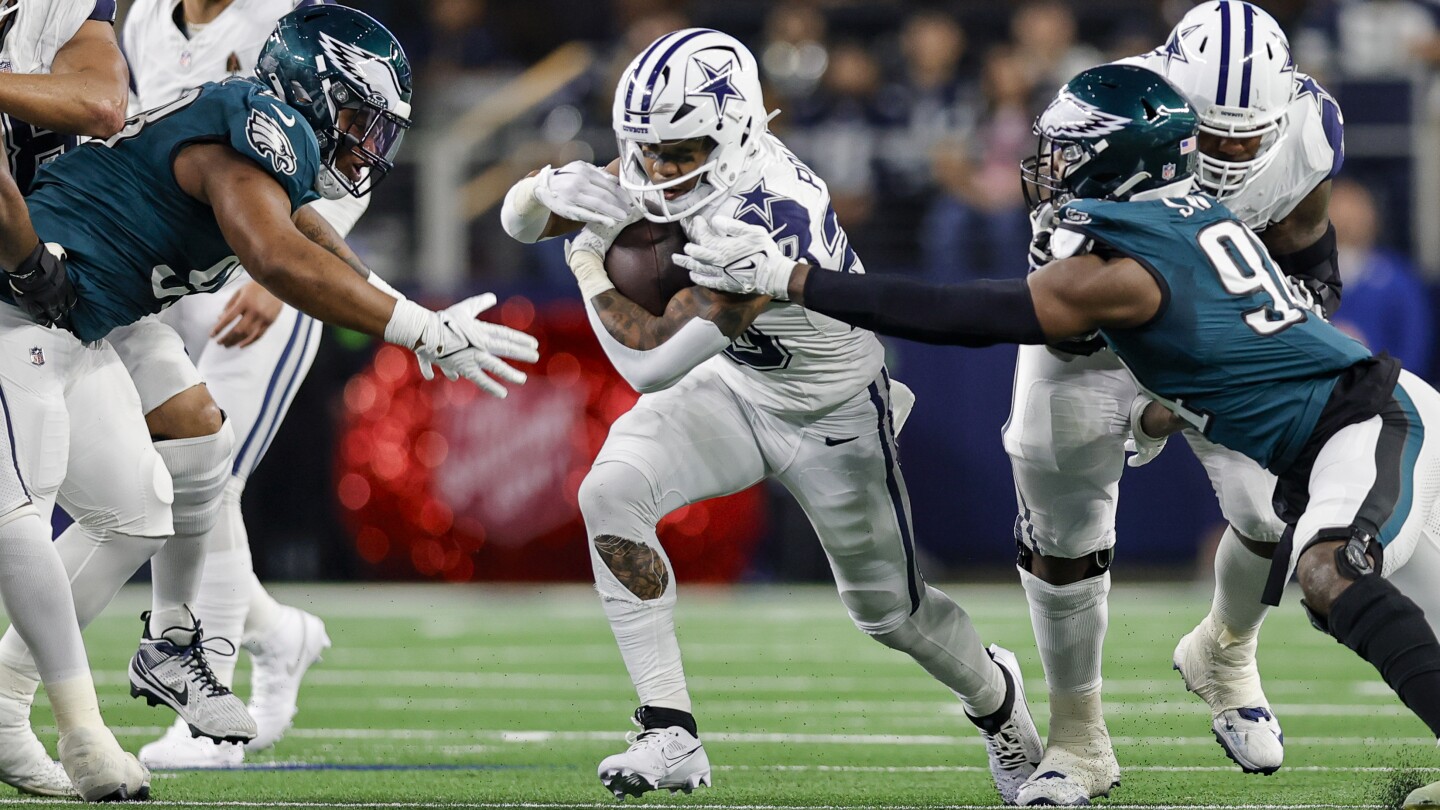NFL: Lexicon of the most important terms in American Football
The NFL dictionary on nfl-news.net. The most important terms of American Football, so that you can follow the National Football League without problems. Here you will find an alphabetical listing of all important terms.
Abdeflected: When a pass is „deflected“, a player from the defense has blocked a pass or at least deflected it in such a way that it does not arrive. If a pass is „abgedeflected“, Patrick Esume has tried to translate his Denglish and is the only one who knows what is meant. By the way, the rest of the terms in this dictionary are meant seriously.
Audible: If the quarterback changes an already announced move shortly before the snap, it is called an audible.
Backfield: In the backfield are those offensive players who are not directly positioned at the line of scrimmage. Among others the quarterback. The defending team has cornerbacks and safetys in the backfield. They are also called „secondary“.
Blind Side: The blind side is the side of the offense to which the quarterback turns his back after the snap. For example, a right-handed player usually uses the left side.
Blind Side Hit: Is a tackle from the blind side. Quarterbacks are therefore usually protected on the blind side by the strongest offensive lineman in the team.
Blitz: A defensive move in which additional defenders rush at the quarterback either to knock him down before the throw or to prevent his pass.
Clipping: Is an illegal block below the belt into the back of the opponent. As a penalty, the team of the fouled player receives a 15 yards space gain.
Complete Pass: A pass that is caught from the air and held securely.
Conversion: The possibility of scoring two extra points after a touchdown with one play. You have to reach the end zone again from two yards away.
Crackback Block: An offensive strategy where a player is near the touchline and runs back to the center of the field at the moment of the snap to block a defensive player for the running back. A crackback block is illegal if the contact is below the waistline. Resulting in a 15-yard penalty.
Delay of Game: A game delay that is penalized with loss of space.
Down: Attempted attack. A team is entitled to four attempts to advance ten yards each time. As a rule, a team kicks at the fourth down, either to attempt a field goal or to make a punt.
Drive: A drive is the sum of all moves. In other words, a complete series of attacks until the opponent is back in possession of the ball.
Draft: The talent draw of the college players over seven rounds. The first pick of the first round is taken by the weakest team of the preseason, the last pick of the first round by the Super Bowl Champion. So it goes round by round until the last pick.
Encroachment: A player moves into the Neutral Zone before the snap and touches an offensive player. Result: Loss of space of 5 yards. The move is interrupted and the attempt is repeated.
End zone: The area on either side of the pitch between the goal line (line between the pitch and the end zone) and the end line (line at the height of the goalposts). The „egg“ must be carried there or caught there to score a touchdown.
Extra point: After a touchdown, the attacking team has the opportunity to score an extra point by kicking from the 15-yard line through the goalposts.
Face Mask: Face Mask is called both the grid of the helmet and a grip into the grid. Important: A grab into the grid is allowed, but if you grab it, the action is considered a foul. (penalty: 15 yards)
Fair Catch: Sign given by a player who decides not to run forward before catching a punt. In this case he may not be attacked by the opponent. If he does not catch or drop the ball, it is a free ball.
Fair Catch Kick: After a Fair Catch, the catching team has the option to make a Field Goal attempt. Advantage: The defense is 10 yards away.
Fake-Interception-Fumble-Recover: A move that only Jan Stecker understands.
False Start: Is a vertical movement of an offensive player. Before the snap, only one player („Man in Motion“) may move parallel to the line of scrimmage.
Field Goal: Successful kick through the goalposts, for which you get three points.
First Down: First of the four attempts available to the attacking team to gain ten yards of space.
Flag: Thrown onto the field by the referees when there is a foul.
Fumble: Dropping the ball when the ball carrier had control of the ball. This often results in a turnaround, the loss of the right to attack. Important here: The player’s contact with the ground cannot cause a fumble – the ball must therefore be knocked out of hand or slip out of control.
Gallic: Adjective used primarily to describe a defence. Synonym for: biting, snappy, malicious. Only used by real NFL experts.
Goes off like shaken seltzer: Definition of speed freely adapted from Patrick Esume.
Yellow line: Optical aid for the TV viewer, showing from which position there is a new first down for the attacking team. However, not all of the transmitting TV stations from the USA offer this feature.
Hail Mary: A long pass (usually not crowned with success) into the end zone shortly before the end of the game. It is thrown by the team behind to score points after all.
Handoff: Is a direct transfer of the ball without throwing it.
Hitch and Pitch: Offensive move in which the quarterback throws the ball to a receiver, which immediately passes the ball back to another receiver or throws it briefly.
Holding: Foul in which a player of the opposing team who is not in possession of the ball is stopped. A holding by an offensive player results in a penalty of 10 yards. If the foul is committed by a defensive player, the team is penalized with a 5 yards space loss and an Automatic First Down for the opponent.
Huddle: Collection of players before they position themselves at the line of scrimmage. In the huddle, the quarterback determines the next move.
Inbound: Means that a player is still within the playing field.
Incomplete Fumble: If the fumble is not secured, but the ball remains free until the game is stopped.
Incomplete Pass: A pass of the quarterback who touches the ground before it is caught and controlled by the receiver. Unlike interception, this does not result in the ball being lost.
Intentional Grounding: Throwing the ball away by the quarterback without a pass receiver in the vicinity. Important: The Intentional Grounding is only whistled if the quarterback is still in the pocket, the area behind the offense line. It is allowed to throw the ball to the ground to stop the time. The clock is stopped at an Incomplete Pass. However, it is forbidden to throw the ball where no player of one’s own team is positioned far and wide, in order to avoid an impending bag of space loss. Exception: The quarterback is outside the pocket.
Interception: Interception of the football from the air, giving the defending team the right to attack.
Interference: Illegal obstruction of a pass receiver or, in the case of kicks, of the kick returning player. In the case of pass interference, the game is continued from the place where the interference occurred.
Kick-off: Kick-off where the kicker kicks the ball forward from the tee (small plastic stand).
Kick Return: Attempt by the defence to carry the ball forward after a kick-off.
Cubic meter claw: Player who is as wide as he is high. According to Patrick Esume.
Lateral pass: It’s a back or lateral pass. In contrast to a forward pass (which may only be thrown once per move and only behind the line of scrimmage), the lateral pass may be thrown as often as desired.
Line of Scrimmage: Imaginary line on which the teams line up to get the ball back into play after an interruption.
Man in Motion: The man in motion is the only player on the offense who may move parallel to the line of scrimmage before the game to cause confusion.
Neutral Zone: Official name of the Line of Scrimmage, which is not a line in itself, as the ball with its circumference determines the extent of the zone.
Neutral Zone Infraction: When a defender moves into the Neutral Zone before the snap and provokes a „false start“ of the offense. The penalty is five yards. The play is immediately interrupted.
No Huddle: The quarterback does not discuss the next move. Usually played under time pressure.
Offside: Offside in American football. The defense is offside when a defensive player is in the neutral zone during the snap. However, the play then continues (unlike in Encroachment or Neutral Zone Infraction). There is a „Free Play“ for the offense. The penalty is five yards.
Onside kick: A kick that is intentionally short and is performed to quickly regain possession of the ball.
Out of Bounds: The area outside the playing field. The out of bounds.
Pass route: Is the rehearsed run of the pass receiver.
Pick Six: Touchdown resulting from an interception.
Play Action: A passing game that is faked with a running game.
Pocket: Is the „pocket“ formed by the offense line players to shield the quarterback from the attacks of the defenders when passing attempts.
PUP list: PUP stands for physically unable to perform, which means that a player is physically unable to train or play. The PUP list will be used for players who suffer a football injury prior to the start of the Regular Season, but who are expected to be fit to play at or during the Regular Season. A distinction is made between Active/PUP and Reserve/PUP. Players who are on the Reserve/PUP list are not allowed to play or train during the first six weeks of the season and do not count as part of the 53-man squad. After these six weeks the team has another six weeks to bring the player back into training, put him on the IR list or dismiss him.
Punt: tee off from the hand. Is practiced by the attacking team as soon as it has not reached the yards required for a first down – usually after the 3rd down. Following a punt, possession of the ball usually changes.
Pylon: Are orange foam blocks that mark the corners of the end zone. The pylon is part of the end zone.
Quarterback: Central position of the player who receives the ball from the centre through his legs, either to hand it to the running back for a rush or to throw it to a receiver across the defensive line. Furthermore, the quarterback himself can run forward with the ball.
Quarterback sneak: The quarterback moves forward immediately after the snap.
Red Zone: The zone of the field between the 20-yard line and the end zone. The Red Zone has no official but statistical meaning and is usually not marked on the field.
Reverse: In a reverse, the running back behind the line of scrimmage passes the ball to a wide receiver running towards it from the opposite direction. The offensive team hopes that the defenders will focus on the running back and that the wide receiver will be able to run relatively unhindered.
Roughing: Is a late attack on kicker or quarterback after the ball has been handed in. The foul is punished with a first down and a 15-yard penalty.
Running Back: A player in this position has the task of carrying the ball as far forward as possible through the defensive line.
Run Pass Option: A Run Pass Option, RPO for short, is a play where the offensive line blocks in such a way that a passing or running play can be played. The decision is ultimately made by the quarterback just before the ball is handed over to the running back. The ball can be passed or the quarterback can throw a pass, depending on what he thinks is the better option In addition, a mobile quarterback can of course also run for the ball himself. For the defense, RPOs are very difficult to defend because of their variability.
Sack: Attack of the defense on the quarterback, where the quarterback is knocked down before he can pass the ball.ezembed
Safety: First of all, it refers to the Libero position in the defense. And secondly: An attacking player in possession of the ball is brought to the ground in his own end zone. This gives the defending team two points.
Scramble: Attempt by the quarterback to avoid the defenders during a passing game in order to gain additional time for the passing attempt.
Screen Pass: The quarterback fakes a long pass but throws a short pass behind the line of scrimmage.
Shotgun: The quarterback is about 5 yards behind the snapper at the snap. The longer distance gives him more time to pass.
Slide: Is a forward slide, feet first after a run. This avoids injuries, because you are not allowed to be attacked while sliding.
Snap: The center’s ball transfer through the legs to the quarterback positioned behind him. With this action the attack begins. At a kick or punt, the center throws the ball to the player behind him.
Speed Option: The Speed Option is a simple method of attacking the outside of the defensive line. This is a running play where the quarterback’s pass to the running back is either faked or actually executed – both options are available. Then an attempt is made to run around the defensive line. The decision whether the quarterback or the running back is running is often made at the last moment, depending on how the defense is read.
Spike: The quarterback deliberately throws the ball to the ground after the snap. A spike is not counted as intentional grounding. After a spike, the clock is stopped. A spike is also counted as a cheering throw of the ball to the ground after a touchdown.
Stiff Arm: The ball carrier extends an arm towards the opponent to avoid a tackle and to keep the opponent at a distance.
Strong Side: Is the side of the offense where the Tight End is placed.
Tackle: Action of the defense, where the player of the opposing team in possession of the ball is held or brought to the ground. A tackle is only allowed opposite the ball carrier.
Targeting: Only available in college football. A tackle against the head or neck is punishable by 15 yards and the player is excluded from the game. If the suspension occurs in the second half, the suspension also applies to the first half of the next game.
Taunting: Taunting is a provocation that is caused by words or gestures directed at the opposing team. Example: A football is thrown or spun towards an opposing player on the ground. A taunting offence will result in a 15-yard penalty.
Three and out: The offense does not reach a first down on its first attack attempt.
Timeout: Time out. Each team is allowed three time-outs per half.
Touchback: If the ball rolls, flies, or the defending team has possession of the ball in the end zone and does not run out of the end zone during kick-off or after a punt, a touchback is awarded. The offense starts its attack move at the 25-yard line.
Touchdown: The goal of an attack, which is achieved when the ball is either carried into the end zone or caught by a receiver located in the end zone. You get six points for a touchdown.
Tripping: Standing up. Is punished with a 10-yard penalty.
Two-minute warning: Two minutes before the end of each half, the referee signals the end of the playing time. The game is stopped.
Two Point Conversion: The attempt to score two extra points after a touchdown. The attacking team forgoes the usual field goal (1 point) and instead makes a complete play from the opposing two-yard line. The attack is successful if the ball is caught by a player in the opponent’s end zone or carried into it. If the two-point conversion is not successful, the attack continues with a kickoff.
Weak Side: The side of the offense where the Tight End is missing.
Wide Receiver: Position that is usually filled by the fastest players on the field. The task of the wide receiver is to catch wide passes from the quarterback and then sprint as far as possible towards the end zone.






Comments
No Comments